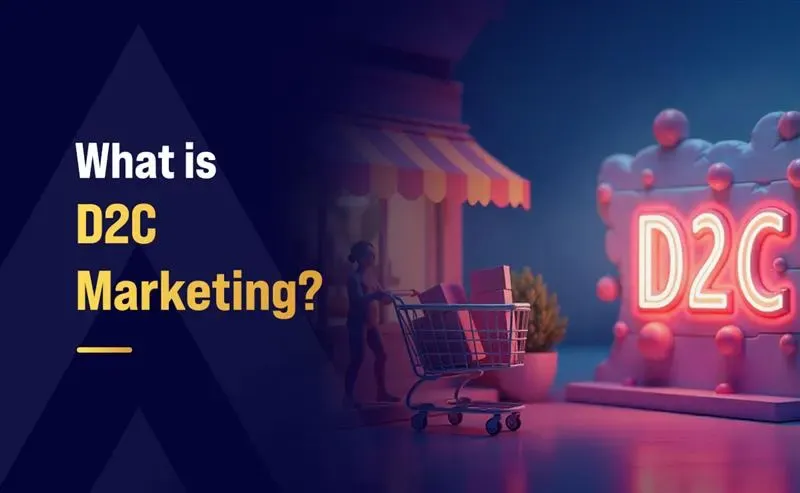What is D2C Marketing?

The direct-to-consumer (D2C) model streamlines the supply chain by directly connecting businesses with consumers, eliminating intermediaries. It leverages e-commerce, internet penetration, and a growing online consumer base to revolutionize retail across industries.
This article takes an in-depth look at the intricacies of what is D2C in marketing, especially within today’s evolving marketplace.
What is the D2C Model?

A D2C model avoids traditional retail intermediaries to control pricing, margins, packaging, and distribution. This gives businesses greater agility and control in product development and testing while keeping shipping costs to a minimum.
The Economic Times states that the Indian D2C market is valued at roughly $16.9 billion in 2023. It is growing at a CAGR of 38% YoY to reach an estimate of $61.3 billion by 2027.
This creates a platform where brands can share their stories and values directly with consumers, contributing to more personalized marketing experiences. Furthermore, D2C brands have access to more customer data, which helps them build efficient campaigns and supervise data-driven changes to strategies on time.
The Pros and Cons of D2C
Advantages:
- Brand Control: Companies have complete control over brand messaging, customer service, and product offerings, leading to more consistent branding and quality control.
- Direct Customer Insights: With direct access to customer data, D2C brands can learn about purchasing preferences, demographics, and behavior, allowing them to create more personalized experiences.
- Higher Profit Margins: Eliminating intermediaries results in lower costs and higher profits, which brands can reinvest in product innovation and customer service.
- Increased Agility: D2C brands are generally more adaptable, able to rapidly adjust to consumer feedback, market trends, and business challenges.
- Enhanced Customer Relationships: Direct communication fosters loyalty, as brands can engage directly with their customers, creating a more personal shopping experience.
Disadvantages:
- Operational Challenges: Handling everything from production to marketing and logistics can be resource intensive.
- Conversion Challenges: To attract customers, D2C brands often offer free trials or low-cost entry points, which can lead to cancellations and limited customer retention if initial value isn't demonstrated.
- Complex Customer Support: Without retail partners, D2C brands bear full responsibility for customer service, including returns and complaints.
- Supply Chain Management: D2C brands must coordinate inventory and logistics themselves, facing potential stock issues and the need for efficient supply chain oversight.
- Increased Competition: D2C has a low barrier to entry, meaning more brands are entering the market, leading to a saturated and highly competitive environment.
How to Be Successful at Direct-to-Consumer Retail?
Customer Expectations and Personalization:
In the D2C model, each step of the customer journey—from product discovery to post-purchase support—shapes customer perceptions.
To meet these expectations, brands must deliver personalized experiences by educating customers about products, offering flexible return policies, and ensuring consistent quality. Providing a unique experience can help D2C brands stand out from established retailers.
Establish a Unique and Relatable Brand Image:

A compelling brand image is crucial for D2C businesses, enhancing customer acquisition and loyalty. Through an omni-channel strategy across websites, social media, and influencer partnerships, brands can establish a strong digital presence.
For emerging D2C brands, gaining market trust requires a targeted approach that focuses on niche recognition and credibility-building.
Simplify the Customer Journey:
Remove unnecessary steps from the buying process to make it as intuitive and seamless as possible. This might mean optimizing your website’s layout, enabling a quick and easy checkout, or even creating mobile-friendly interfaces to accommodate on-the-go shoppers.
Offering features like one-click purchasing or guest checkout can also reduce friction and encourage faster conversions.
Investing in Essential Resources:
Establishing a D2C model demands investments in essential tools and resources. It includes payment processing systems, customer relationship management (CRM) software, transactional email services, and detailed analysis of consumer data.
Employing skilled professionals to manage these resources and develop clear financial strategies is essential for long-term viability, including tracking D2C sales impact on overall business health.
Be Agile and Open to New Technologies:
Agility is key in the D2C model. Tools like artificial intelligence, machine learning, and chatbots can elevate customer service and generate insightful data.
Brands that are open to experimenting with these tools can better respond to shifting market trends and consumer needs. Furthermore, adopting new tech enables brands to scale personalized experiences, which strengthens customer satisfaction and loyalty.
How to Make Your Retail D2C Ready?
To make your retail business D2C (direct-to-consumer) ready, you need to focus on optimizing processes, centralizing data, and selecting the most effective online channels to engage customers. Here’s a breakdown of how to do it:
Process and Personnel Transition Plan
To successfully transition to a D2C model, establish a streamlined process that optimizes inventory, fulfillment, and customer service. You’ll also need to invest in training your team to handle D2C-specific tasks such as customer service, order processing, and data management.
This approach helps businesses remain agile and ready to expand as demand increases. A strong people movement plan ensures your team can quickly adapt to market changes, keeping customer experience at the center of all decisions.
Implementing a Centralized Data Platform
Centralizing all customer and transactional data under a unified platform enables a comprehensive view of buyer behavior, preferences, and transaction history.
Using an advanced CRM platform that integrates multiple tools and channels can help capture behavioral insights, segment your audience, and personalize marketing efforts.
A centralized system ensures consistency across all channels, providing a comprehensive view of performance and making it easier to respond to customer needs promptly.
Select Effective Online Channels
Selecting the right online channels is key to engaging your target audience. Start by evaluating where your customers are most active, whether that’s on social media, mobile apps, or search engines.
Focus on building your presence across a few high-impact platforms rather than trying to spread yourself thin.
Invest in creating an omnichannel experience that integrates your website, mobile apps, and social commerce. With the right channel mix, you can drive brand awareness, conversions, and customer loyalty easily.
Effective Direct-to-Consumer (D2C) Marketing Strategies
While D2C marketing shares similarities with traditional B2C strategies, it requires distinct approaches due to its direct connection with consumers. Here are five powerful D2C strategies that manufacturers can implement to maximize their impact:
Social Media Marketing
Social media platforms, including Instagram, Facebook, and TikTok, serve as vital channels for manufacturers to engage directly with their customers. Through organic and paid content, brands can build communities, engage with customers, and drive traffic to D2C channels.
By harnessing influencer collaborations, user-created content, and paid advertising, manufacturers can extend their reach and nurture brand loyalty.
Search Engine Optimization (SEO)
SEO is a key tactic for boosting organic traffic and increasing direct sales from search engines. By optimizing websites with relevant keywords, creating valuable content, and building quality backlinks, manufacturers can ensure their websites rank highly for relevant searches.
Targeting long tail and branded keywords can draw specific audiences. SEO requires ongoing effort and attention for sustainable results.
Influencer Marketing
Micro-influencers can be powerful allies for manufacturers. By partnering with influencers who resonate with their target audience, brands can authentically introduce their products to new consumers.
This strategy leverages a micro influencer's niche followings to boost brand awareness and credibility. Additionally, micro-influencers often work for lower fees or even in exchange for products, making this strategy budget friendly.
Email Marketing
Email marketing remains a powerful method for cultivating customer relationships and promoting sales. By segmenting email lists and creating personalized campaigns, manufacturers can deliver targeted messages that resonate with their audience.
From welcome emails to follow-ups after purchases, email campaigns keep brands connected to customers and encourage repeat purchases. Additionally, Email marketing helps gather valuable customer data like purchase history and preferences, enabling brands to refine their marketing strategies.
Conversion Rate Optimization (CRO)
CRO focuses on improving the effectiveness of existing traffic by optimizing the user experience and boosting conversions.
By testing strategies like free shipping, faster load times, and simplified checkout, businesses can significantly increase sales. A systematic approach to testing and analysis is key to continuous improvement.
Additionally, conversion rate optimization (CRO) helps pinpoint and resolve site issues that could prevent conversions, like broken links or confusing layouts.
Pay-Per-Click (PPC) Marketing
PPC marketing allows manufacturers to gain immediate visibility and drive targeted traffic through paid ads.
Through platforms like Google Ads and Facebook Ads, manufacturers can reach active customers with well-crafted ads and precise keyword bidding. This strategy complements organic conversions, driving quick sales and brand awareness at a controlled cost.
Social Activism
Social activism allows D2C brands to differentiate themselves by aligning with consumer beliefs. By taking a stand on relevant issues like sustainability or diversity, brands can build strong connections with their audience.
Genuine social activism not only builds brand loyalty but also sparks positive word-of-mouth, attracting socially conscious consumers inclined to support value-driven brands.
FAQs
Q1. What is the difference between D2C and B2C?
Ans: D2C (direct-to-consumer) and B2C (business-to-consumer) both involve selling directly to consumers. However, D2C refers specifically to brands that cut out intermediaries like retailers or wholesalers, selling directly through their website or physical stores.
B2C includes all businesses that sell to consumers, but through various channels, including retail stores or third-party platforms like Amazon.
Q2. What is D2C marketing? Give an example.
Ans: D2C (direct-to-consumer) refers to brands selling directly to their customers without third-party involvement. For example, Warby Parker, an eyewear brand, sells directly to customers through its website and physical stores, allowing them to bypass traditional retailers.
Q3. What is D2C vs. B2B marketing?
Ans: D2C marketing focuses on reaching and selling directly to end consumers, often using online channels, social media, SEO, and personalized content. B2B (business-to-business) marketing, however, targets other businesses as customers, emphasizing long-term relationships and often using trade shows, direct sales, and industry-specific content.
D2C marketing tends to be more consumer-driven and personal, while B2B marketing focuses on addressing business needs and solutions.
Summing Up
In conclusion, the direct-to-consumer (D2C) model is revolutionizing retail by offering brands greater control, deeper customer insights, and the ability to foster stronger, personalized relationships with consumers. Hence, roles related to D2C require specialized education like an MBA or PGP to position itself for success.
While there are challenges such as operational complexity and increased competition, the benefits—like improved margins and enhanced agility—make it an attractive option for businesses. By embracing innovative marketing strategies and investing in essential resources, D2C brands can thrive in the ever-evolving digital marketplace.





